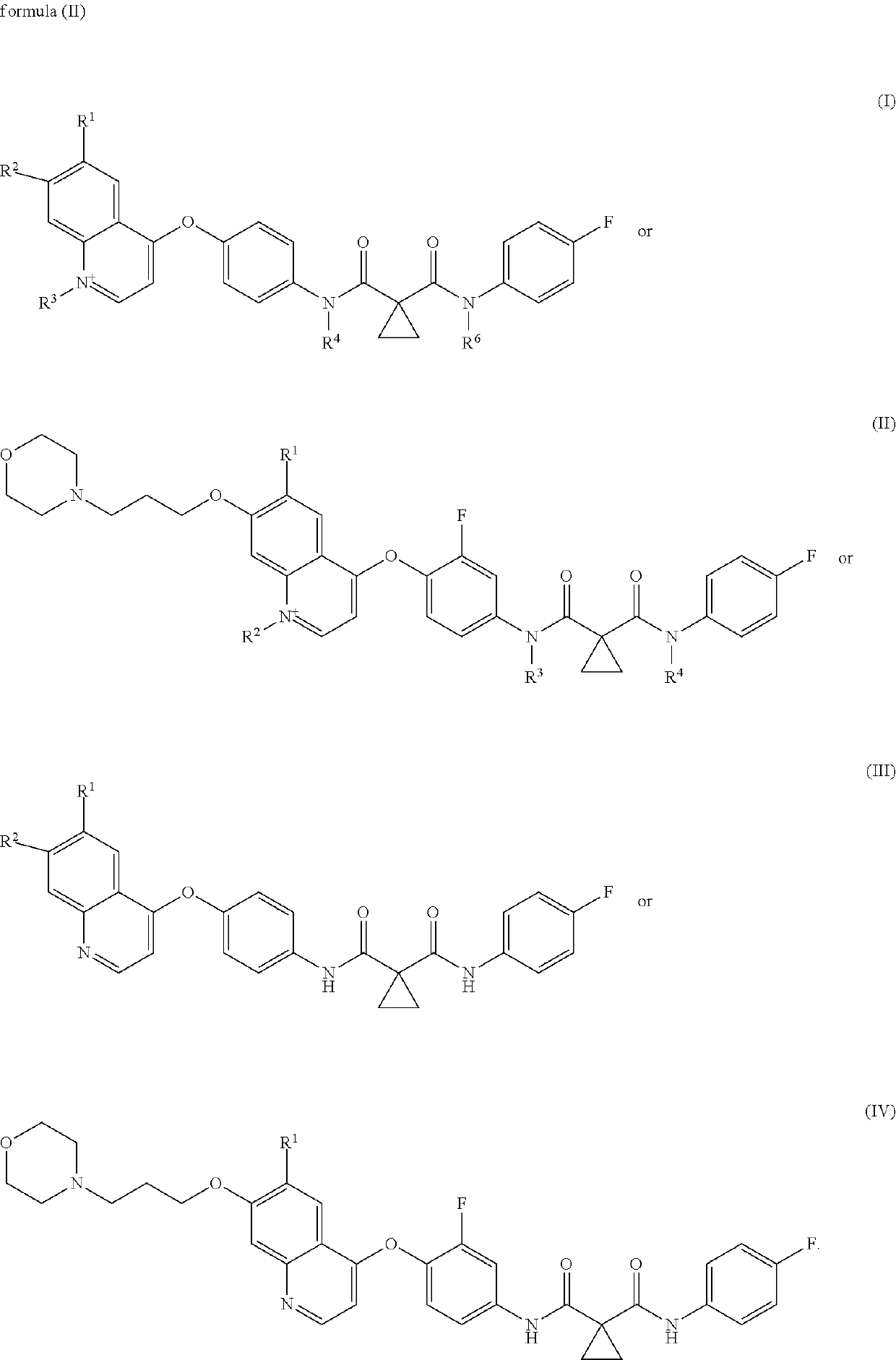Multi-tyrosine kinase inhibitors derivatives and methods of use
a technology of tyrosine kinase and derivatives, applied in the field of multi-tyrosine kinase inhibitor derivatives, can solve the problems of vision loss, capillary dropout, microaneurysms, leakage of retina, etc., and achieve the effect of suppressing or preventing wet macular degeneration
- Summary
- Abstract
- Description
- Claims
- Application Information
AI Technical Summary
Benefits of technology
Problems solved by technology
Method used
Image
Examples
example 1
Synthesis of Cabozantinib N-Acyl Methyl Palmitate
[0129]
Method
[0130]Cabozantinib was incubated with bromomethyl palmitate in the presence of tetraphenylborate (“NaBPh4”), acetonitrile (“CH3CN”) at 82° C. for X hours resulting in cabozantinib N-acyl methyl palmitate tetraphenylborate. The cabozantinib N-acyl methyl palmitate tetraphenylborate is then incubated with Dowex®-1-chloride (Dowex is a registered trademark of Dow Chemical Company) and acetonitrile:isopropyl alcohol (iPA) to yield cabozantinib N-acyl methyl palmitate chloride.
example 2 (
Virtual)
Formulation
[0131]Cabozantinib N-acyl methyl palmitate (CNAMP) was formulated for intravitreal injection using isopropyl myristate or oleic acid combined with about 10% w / v cyclodextrin and from about 10% to about 30% w / v D-alpha tocopherol PEG 1000 succinate (“TGPS”) which were then solubilized via well-known oil solubilization techniques to create a first solution. The first solution was then added to a saturated fatty acid (e.g. octanoic acid) combined with lecithin or lecithin derivatives (e.g. phosphatidyl choline), a glycerol fatty acid ester (e.g. propylene glycol fatty acid esters such as polyoxyethyleneglycerol triricinoleate), a sorbitan fatty acid ester (e.g. Span® 20, Span® 80) or a olyoxylethylene sorbitan fatty acid ester (e.g. Tween® 20, Tween® 80), and optionally a co-surfactant (e.g. propylene glycol, glycerol, PEG 400, 1,2-propanediol), which were then solubilized as a microemulsion using commercial lipoemulsion techniques (e.g. Intralipid®, Abbolipid).
Metho...
example 3
Method
[0135]Compounds 2-4 and cabozantinib were each tested for binding of c-Met, VEGFR2, TIE2 and the control compound, staurosporine. Specifically, each compound was tested at a 3-fold serial dilution starting at 10 microMolar (“μM”) in a10-dose IC50 mode into an enzyme / substrate mixture using acoustic technology, and pre-incubated for 20 minutes to ensure compounds were equilibrated and bound to the enzyme. Staurosporine was used as a control and was tested at a 4-fold serial dilution starting at 20 μM. Next, 5 concentrations of ATP were added to initiate the reaction. The activity was monitored every 5-15 min for a time course study.
[0136]
TABLE 3IC50 Data for Compound 2 on Various KinasesCompound IC50* (M):Kinase[ATP] (μM):StaurosporineCabozantinibCompound 2c-Met102.16E−073.76E−06VEGFR2201.86E−08TIE2301.20E−074.90E−07*Empty cells indicate no inhibition or compound activity that could not be fit to an IC50 curve for any of the 3 kinases.
Results
[0137]As can ...
PUM
| Property | Measurement | Unit |
|---|---|---|
| volume | aaaaa | aaaaa |
| intraocular pressure | aaaaa | aaaaa |
| molecular weight | aaaaa | aaaaa |
Abstract
Description
Claims
Application Information
 Login to View More
Login to View More - R&D
- Intellectual Property
- Life Sciences
- Materials
- Tech Scout
- Unparalleled Data Quality
- Higher Quality Content
- 60% Fewer Hallucinations
Browse by: Latest US Patents, China's latest patents, Technical Efficacy Thesaurus, Application Domain, Technology Topic, Popular Technical Reports.
© 2025 PatSnap. All rights reserved.Legal|Privacy policy|Modern Slavery Act Transparency Statement|Sitemap|About US| Contact US: help@patsnap.com



